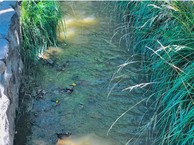Stormwater Runoff in Santa Fe County

Last month, the Sustainability Office gave a presentation to the Board of County Commissioners on the management of stormwater runoff in Santa Fe County. Stormwater runoff is generated when rain or snowmelt flows over impervious surfaces, such as roads, parking lots, and rooftops, rather than seeping into the ground. As it moves across the landscape, runoff can wash oils, bacteria, chemicals, trash, and other pollutants into waterways. To protect water quality, the federal National Pollution Discharge Elimination System (NPDES) program requires a permit to discharge stormwater runoff from certain municipal separate storm sewer systems (MS4s) and other activities. An MS4 includes publicly owned or operated streets, catch basins, ditches, storm drains, culverts, and other structures that might collect or transport stormwater runoff.
The City of Santa Fe, New Mexico Department of Transportation, and the urbanized area of Santa Fe County fall under permit number NMR040000. Permittees are required to implement a stormwater management program that addresses six control measures to prevent pollutants from entering waterways through runoff. These measures include strategies for 1) public education; 2) public engagement in stormwater management activities; 3) addressing illegal dumping and spills that could contaminate stormwater; 4) managing stormwater runoff from construction activities; 5) addressing stormwater runoff in new development and redevelopment; and 6) preventing pollution from municipal operations.
In Santa Fe County, stormwater management responsibilities are distributed across the Public Works Department, Growth Management Department, and Sustainability Office. For example, the Public Works Department manages stormwater along roadways and municipal worksites throughout the County. Public Works also helps to keep litter out of waterways by collecting and properly disposing of several thousand tons of trash and recycling each year at its convenience centers. The Growth Management Department reviews building plans and oversees code enforcement actions to ensure compliance with County codes to manage runoff. This Department also houses a team of staff that work on open space and park projects to educate the public and protect natural resources. Lastly, the Sustainability Office implements public outreach and education activities to promote environmental stewardship. These include annual Earth Day events, recycling education, and water conservation initiatives.
Every drop of water counts in our dry climate. Santa Fe County is currently working with consulting firm Bohannan Huston, Inc. to update and improve its stormwater management program to protect our waterways. This is an opportunity to protect water quality, continue to support river restoration projects, and promote the use of green stormwater infrastructure, like rain gardens, to soak up runoff and support plant life. Click here to learn more about stormwater management in the County and to view the County’s 2021 MS4 annual report to the Environmental Protection Agency. The County invites public comment on the report through October 1st at 5:00 p.m.
Check out the last article in this month’s newsletter to learn what you can do to prevent stormwater pollution!
|
Managing Invasive Plants and Promoting Pollinators

This year’s monsoon season has greened up gardens and landscapes throughout Santa Fe County. While many beneficial native plants have flourished thanks to the extra water, so have invasive plants. Native plants occur naturally in a region and have evolved as part of the ecosystem where they provide important habitat for native insects, birds, and other wildlife. An invasive plant, on the other hand, has intentionally or unintentionally been introduced into an area where it then causes harm to the local environment, economy, or human health. For example, dalmation toadflax (Linaria dalmatica) is native to the Mediterranean and is thought to have been introduced intentionally to the United States as an ornamental plant in the 1800s. In the U.S., it aggressively spreads through roadsides and fields, displacing native plants. Russian thistle (Salsola tragus), also known as tumbleweed, is native to parts of Europe and Asia. The plant is believed to have been introduced accidentally to the U.S. as a contaminant in flax seeds in the 1800s and has since spread throughout the West. In New Mexico, the plant disrupts native ecosystems and poses a fire hazard as dried tumbleweeds accumulate along fences and buildings.
Early detection is key to managing invasive plants on your property. Click here for a list of weeds to watch for in New Mexico. Management strategies for invasive plants depend on the species and the extent of the infestation. Pulling or digging up the plant by the root before it goes to seed can help to manage small infestations. Be mindful of a plant’s potential to become invasive when shopping for new plants for your garden. The Guide to Native Plants for the Santa Fe Landscape includes a helpful list of native plants that you can incorporate into your garden. Familiarize yourself with the list of noxious and troublesome weeds of New Mexico before you shop for plants. This list currently highlights a few common garden plants that have the potential to become problematic in New Mexico. These include myrtle spurge (Euphorbia myrsinites, sometimes referred to as donkey tail spurge) and pampas grass (Cortaderia selloana). Try replacing pampas grass with native deergrass (Muhlenbergia rigens) or swapping out myrtle spurge for native prairie sagebrush (Artemisia frigida) for a low maintenance and wildlife-friendly landscape!
While getting rid of noxious weeds, you can simultaneously work with nature in your landscaping by leaving in place and nurturing any pollinator-friendly and native plant "volunteers" that are already naturally growing in your garden and on your property!
Happy gardening!
|
Help Prevent Stormwater Pollution!
Imagine looking out the window as the rain falls on a summer day. You may see water flowing across roofs, through canales, down driveways, over roads, and into ditches, arroyos, and rivers. Runoff is generated as rain and snowmelt washes across impervious surfaces, rather than seeping into the ground. As runoff flows across the landscape, it picks up sediment, motor oil, bacteria from pet waste, household chemicals, litter, and other pollutants. Polluted runoff eventually makes its way into our waterways where it can impact water quality.
Here are just a few things you can do to help protect our waterways from runoff pollution:
-
Properly dispose of household hazardous waste: Correctly dispose of motor oil and other household hazardous waste to prevent this material from entering our waterways. The Santa Fe Solid Waste Management Agency accepts household hazardous waste at the Buckman Road Recycling and Transfer Station on Fridays and Saturdays. Click here for details on what is accepted. Santa Fe County accepts automotive fluids from residents at the Eldorado, Nambe, San Marcos, and Stanley convenience centers. Visit the County Solid Waste Management webpage for details.
-
Pick up after your pet: Pet waste left in your yard, along sidewalks, on hiking trails, and in parks can wash into waterways where it introduces bacteria and other pollutants that pose a threat to humans and the environment. Be sure to clean up after your pet. Consider attaching waste bags to your pet’s leash so you are always prepared.
-
Properly dispose of trash and recyclables: Runoff can also transport litter into waterways. Securely store and properly dispose of trash and recyclables to prevent this. Click here to learn more about recycling in Santa Fe County.
-
Store the water for a not so rainy day: Did you know that a 1,000 square foot roof can collect 600 gallons of water from just 1 inch of rain? Investing in rainwater catchment systems, such as cisterns and rain barrels, allows you to save this precious water for later use. Plus, these systems reduce the amount of runoff that might transport pollutants into waterways. Click here to view Chapter 7.13.11.7 of the County’s Sustainable Land Development Code to learn about water catchment requirements.
-
Create a rain garden: Create an oasis for people, birds, and butterflies by redirecting runoff into a rain garden. Rain gardens help to soak up water and filter pollution from runoff. Click here to view examples of these gardens around Santa Fe.
-
Manage erosion: Exposed soil can quickly wash off your property and into waterways during a rain event. Maintain native plants on your property to help prevent erosion. Use erosion control devices, such as mats or straw wattles, to temporarily stabilize soil until you can address the issue through planting or other methods.
In addition to generating runoff, heavy rain events can also pose a threat to public safety. Last month, Santa Fe County declared an emergency due to destructive floods that followed rain storms this summer. Click here for ways to stay safe during flooding.
Stay safe and thanks for all you do to protect our water!
|